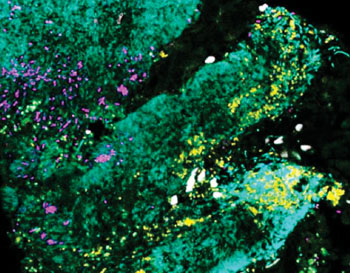Bacterial Biofilms Associated with Colon Cancer
By LabMedica International staff writers
Posted on 22 Dec 2014
An imaging technology reveals that bacterial biofilms are associated with colon cancer (CRC) and the discovery draws on a novel way to observe microbial community structure.Posted on 22 Dec 2014
The technology called combinatorial imaging could potentially be used to clinically diagnose pre-cancerous and cancerous conditions in the ascending colon, the part nearest to the small intestine. Cancerous tumors in the ascending colon are characterized by biofilms, which are dense clumps of bacterial cells encased in a self-produced matrix.

Image: Bacteria forming a mixed biofilm on colon cancer tissue (Photo courtesy of Jessica Mark Welch, Blair Rossetti, and Christine Dejea).
Scientists at Johns Hopkins Medical Institutions (Baltimore, MD, USA) working with colleagues at the Marine Biological Laboratory, (Woods Hole, MA, USA) collected for analysis excess colon tumor, adenomas and cancers, and paired normal tissues from patients undergoing surgery. Healthy control patients undergoing screening colonoscopy or colonoscopy for diagnostic workup were also enrolled.
Colon tissues were analyzed with up to 11 fluorescent in situ hybridization (FISH) probes for bacterial composition and biofilm bacterial density and depth; by scanning electron microscopy (SEM), fluorescence microscopy for interleukin 6 (IL-6), and E-cadherin, enzyme-linked immunosorbent assay (ELISA) for (IL-6), and immunohistochemistry for pStat3, Ki67. Extracted sample DNA was amplified and sequence to determine the V3–V5 region of 16S rDNA using the Roche 454 method (Roche diagnostics; Branford, CT, USA).
The team identified invasive polymicrobial bacterial biofilms or bacterial aggregates structures previously associated with nonmalignant intestinal pathology. They were nearly universally on right-sided tumors (13 of 15 CRCs, 4 of 4 adenomas), but on only 12% of left-sided tumors (2 of 15 CRCs, 0 of 2 adenomas). Patients with biofilm-positive tumors, whether cancers or adenomas, all had biofilms on their tumor-free mucosa far distant from their tumors. Bacterial biofilms were associated with diminished colonic epithelial cell E-cadherin and enhanced epithelial cell IL-6 and Stat3 activation, as well as increased crypt epithelial cell proliferation in normal colon mucosa.
Jessica L. Mark Welch, PhD, a coauthor of the study, said, “This is the first time that biofilms have been shown to be associated with colon cancer, to our knowledge. This suggests that either the tumor allows the biofilm to form, or the biofilm is helping to cause the tumor. The breaching of the mucus layer could allow bacteria to come into contact with the host epithelial cells, and that is one thing that could lead to cancer.” The study was published on December 8, 2014, in the journal Proceedings of the National Academy of Sciences of the United States of America (PNAS).
Related Links:
Johns Hopkins Medical Institutions
Marine Biological Laboratory
Roche Diagnostics













